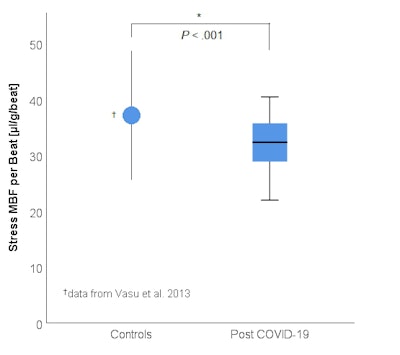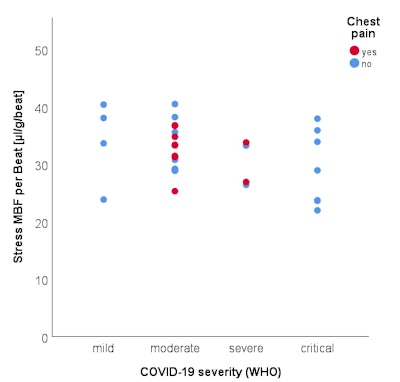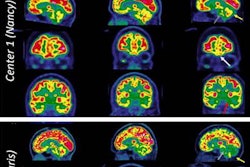
A German-led study has identified a significantly reduced microvascular perfusion post COVID-19 compared with healthy controls, irrespective of symptoms and COVID-19 severity.
Persistent cardiopulmonary symptoms after COVID-19 have been reported in many patients, and the underlying pathology is still poorly understood, Dr. Patrick Doeblin, a specialist in internal medicine and cardiology at the German Heart Institute Berlin, and colleagues told virtual attendees at the European Society of Cardiology (ESC) annual congress, which ended on 28 August.
"Several cardiac MRI studies have found subtle alterations in functional and tissue parameters, mostly unrelated to symptom severity," they explained in an ESC 2021 e-poster. "Histopathologic studies revealed myocardial macrophage infiltrates in deceased patients, likely an unspecific finding of severe illness, and increased prevalence of micro and macrovascular thrombi."
 Dr. Patrick Doeblin.
Dr. Patrick Doeblin.Therefore, the authors examined whether microvascular perfusion, measured by quantitative cardiac MRI under vasodilator stress, was altered post COVID-19.
The study sample consisted of 12 patients from Berlin's Charité Hospital who received a cardiac MRI exam as part of a systematic follow-up after discharge, 10 patients who presented at the German Heart Center in Berlin with persistent cardiac symptoms post-COVID-19, and 12 COVID-19 patients from King's College London who were referred for stress MRI.
The scan protocol included standard functional, edema, and scar imaging and quantitative stress and rest perfusion to assess both macro- and microvascular coronary artery disease. The pharmacological stress agent was regadenoson in 20 patients and adenosine in 13 patients. To control for the higher heart rate increase under regadenoson compared with adenosine, the authors calculated myocardial bloodflow (MBF) per heartbeat under stress.
"No patient fulfilled the updated Lake Louise criteria for myocarditis based on the cardiac MRI examination," they stated. "None of the 33 patients exhibited myocardial edema on visual analysis of T2 STIR imaging."
One patient with a previous history of myocarditis showed focal chronic fibrosis. Three patients with known coronary artery disease showed ischemic late gadolinium enhancement. Five patients had a small pericardial effusion; one of these five patients showed slight focal pericardial edema and late gadolinium enhancement, consistent with mild focal pericarditis. Five patients had a stress-induced regional perfusion deficit (four were consistent with coronary artery disease and one with microvascular dysfunction in the presence of left ventricular hypertrophy).
One patient was excluded from MBF per heartbeat analysis due to atrial fibrillation with varying heart rate.
 Stress myocardial bloodflow in post-COVID patients compared with healthy controls. (Based on data from Vasu S et al. Two figures courtesy of Dr. Patrick Doeblin, Prof. Dr. Sebastian Kelle, and ESC 2021.
Stress myocardial bloodflow in post-COVID patients compared with healthy controls. (Based on data from Vasu S et al. Two figures courtesy of Dr. Patrick Doeblin, Prof. Dr. Sebastian Kelle, and ESC 2021. Quantitative MRI parameters by symptoms and COVID-19 severity.
Quantitative MRI parameters by symptoms and COVID-19 severity.Stress MBF was significantly lower (31.8 ± 5.1 microliters/beat vs. 37.8 ± 6) in post-COVID-19 patients compared with the control group, as shown in Figure 1. Stress MBF was not correlated to COVID-19 severity or presence of symptoms (see Figure 2).
Looking to the future
The group is currently taking part in a multicenter cohort study of the long-term cardiac effects of COVID-19, Doeblin told AuntMinnnieEurope.com.
"We still need to find out whether the reduction in microvascular perfusion is caused by the COVID-19 infection or confounding variables such as age and comorbidities," he pointed out. "From what is known about the cardiovascular pathophysiology of COVID-19, we were surprised that we did not find a greater difference."
The clinical significance of this difference is still unknown, he continued. For example, the team was surprised to find no difference in microvascular perfusion between symptomatic and asymptomatic patients.
"Of note, five of our 33 patients showed regional perfusion defects, and coronary artery disease should always be considered as a differential diagnosis in symptomatic patients after COVID-19," Doeblin said.



















